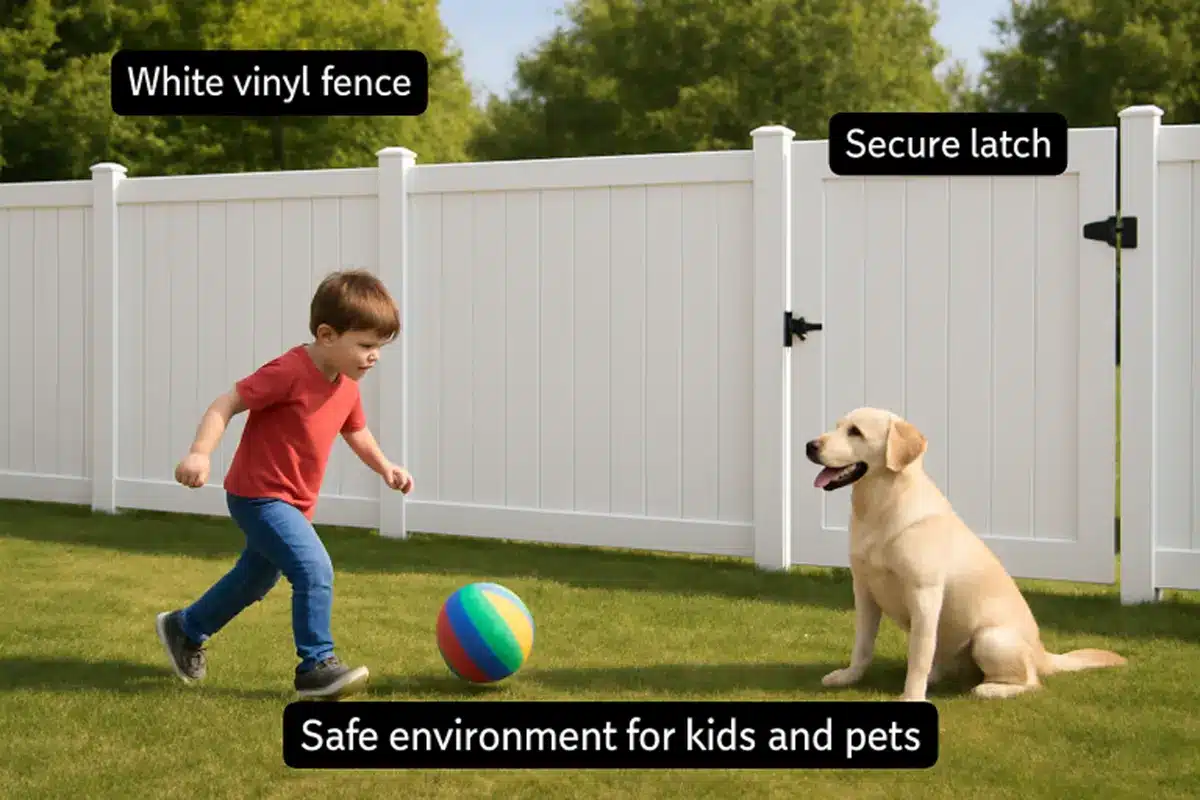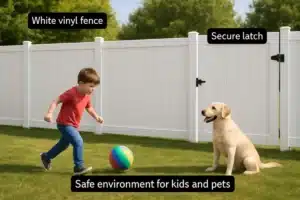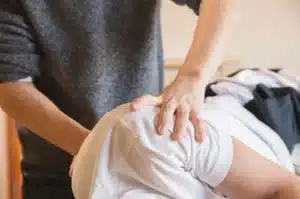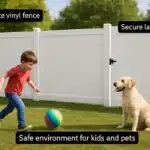Key takeaways:
- The right fence provides essential safety for both children and pets.
- Quality materials and proper installation ensure long-term durability and security.
- Secure gates, proper height, and spacing prevent accidents and escapes.
- Thoughtful design can enhance your home’s curb appeal while improving safety.
Introduction
Designing a backyard that prioritizes the safety and happiness of children and pets is an essential consideration for families today. Establishing a secure outdoor space provides invaluable peace of mind for parents and pet owners alike in a world where children are curious and pets are adventurous. A thoughtfully constructed fence isn’t just about defining property lines—it’s a protective boundary that gives kids and pets the freedom to play, explore, and enjoy the outdoors with reduced risks. The assurance that little ones and furry friends are shielded from hazards, such as roads or neighboring yards, cannot be understated. More homeowners are turning to reliable solutions such as vinyl fence installation in Northern Virginia to combine safety, style, and durability in a single investment. These modern fencing options can also help accommodate design tastes and neighborhood aesthetics.
Fencing can elevate your home’s curb appeal while serving its fundamental role as a critical barrier against hazards, stray animals, and unwanted access. Parents and pet owners can make confident choices that fit their family’s needs and local requirements by understanding what makes a fence safe and practical. From material choices to construction details, every fence design element contributes to safety, comfort, and enjoyment in your outdoor sanctuary.
Key Safety Features in Fencing
Appropriate Height and Structure
Height is a vital element in fence safety and is crucial in keeping kids and pets confined within boundaries. Most experts recommend that fencing designed with children in mind should stand at least 4 feet high, as this makes it difficult for young kids to climb over. However, active or larger pets, such as athletic dogs, may require fences that stand 5 to 6- feet tall fences for adequate containment. Consider fences with vertical pickets instead of horizontal rails to minimize climbing risks. Vertical pickets make it much harder for small hands or paws to find a foothold and scale the fence. Choose designs that don’t have easy footholds or gaps that could encourage scaling the fence, and make sure any decorative elements are placed well above a child’s reach.
Safe Materials
Ensuring your fence is crafted from safe and non-toxic materials is fundamental. Traditional wooden fences can splinter, while metal options may rust or develop sharp edges over time. Opt for smooth-surfaced options like vinyl or powder-coated aluminum, as these materials are less likely to splinter or rust and won’t leave kids or pets with scratches or hazardous fragments. These fencing types also typically require less maintenance, giving families more time to enjoy their yards without constant repairs or treatments. Additionally, these materials resist chewing and scratching, which is ideal for households with dogs. Find more information about safe fencing materials through resources, where you can compare options and learn which materials are safest for kids and pets.
Proper Spacing Between Slats
Fences with slats spaced too far apart can present serious risks, allowing pets to wriggle through, children to get a limb or their head stuck, or even enabling them to reach hazardous objects outside the yard. As a best practice, keep vertical gaps under 3 inches. This guideline helps prevent squeezing, entrapment, and injuries, making the fence more secure, especially for smaller pets and toddlers. An appropriate gap also keeps small wildlife from entering your property, offering additional peace of mind. Consider fencing styles explicitly designed with narrow picket spacing for added child and pet safety.
Secure Gates and Latches
Gates are often the weakest point in a fence system. For optimal safety, choose self-closing gates and feature childproof latches installed outside children’s reach. These latches can prevent curious children or pets from wandering out of your yard and into surrounding areas. Regularly check that latches and hinges remain tight and in good working order. Smart latches or lockable systems provide another layer of security, especially in busy neighborhoods or areas with nearby water hazards or traffic. Properly installed gates should also swing inward, preventing determined pets from pushing them open.
Practical Considerations for Fence Design
Visibility and Supervision
Keeping play zones visible from inside your home or patio enables better supervision, which is one of the most effective ways to prevent accidents before they happen. Privacy fencing can be balanced with visibility by choosing semi-private styles or panels with small, staggered gaps. This design approach allows caregivers to observe children and pets easily while protecting their privacy. Glass panels, latticework, or decorative metal inserts can enhance sightlines without compromising security. Consider the layout of your yard and place fences so open play spaces remain within view from commonly used rooms such as the kitchen or family room.
Durability and Maintenance
Durability should never be overlooked when designing a safe fence, as active play and weather exposure quickly wear down subpar materials. Choose materials that withstand active play, chewing, scratching, extreme weather, and general wear and tear. Fencing made from vinyl and aluminum performs excellently in these areas and reduces the long-term costs and time commitment of painting, staining, and fixing common issues. Periodic inspection for damage or weakness, especially after storms or roughhousing, is important to maintain safety.
Compliance with Local Regulations
Every municipality has specific requirements about fence height, materials, and distance from the property line. Some neighborhoods or homeowners’ associations outline permitted colors, styles, and post placements. Before starting your project, review your local building codes and homeowners’ association guidelines to ensure compliance. This step prevents future headaches, fines, and potential removal orders, and ensures your new fence fits into the neighborhood’s fabric. Failing to adhere to these rules can result in costly corrections, so securing all necessary approvals in advance is best.
Additional Safety Enhancements
Rounded Edges and Smooth Surfaces
Look for fences with rounded tops, edges, and corners to reduce the risk of cuts, bruises, or scrapes during outdoor play. Metal and vinyl fencing can offer smooth, seamless options, while wood fences require extra finishing. If opting for a wooden fence, carefully sand all surfaces, seal the wood, and regularly inspect for splinters or exposed fasteners. By prioritizing smooth, snag-free finishes, you help guarantee outdoor adventures remain safe for all ages. Periodic maintenance helps avoid hidden hazards that could become serious injuries.
Incorporating Landscaping
Strategic landscaping can fortify your fence’s effectiveness and improve the appearance of your yard. Place thorny or dense bushes next to the fence to deter climbing and create an attractive green buffer. Choose non-toxic plants if pets will be spending time near the foliage, and consider mulch or ground cover to reduce muddy paws and shoes being tracked indoors. Shrubbery and flower beds can soften fence lines and provide additional barriers to curious explorers. Thoughtful landscaping with textured or aromatic plants can stimulate pets, making the yard a richer environment for everyone.
Final Thoughts
Ensuring your fence design addresses essential safety features—from height and materials to latches and visibility—creates a backyard oasis that kids and pets can confidently explore. When thoughtfully planned, fencing protects your loved ones, beautifies your property, and adds long-term value. Consult with a reputable fencing contractor to make informed choices, and always adhere to community standards. With careful preparation, your outdoor space will be a haven for your entire family, allowing years of joyful memories to be made just steps from your door.
Also Read–Top 10 Birthday Party Games for Kids Under 8










